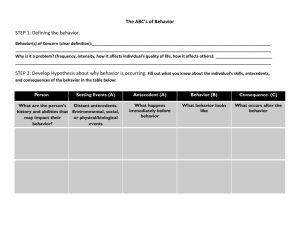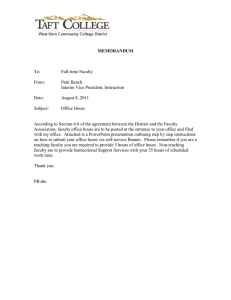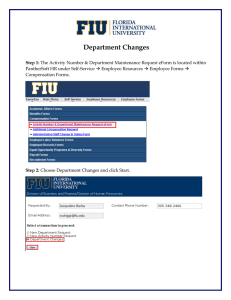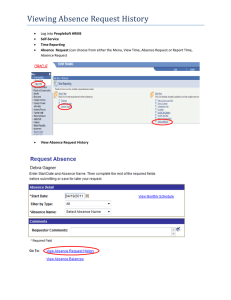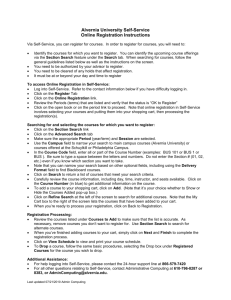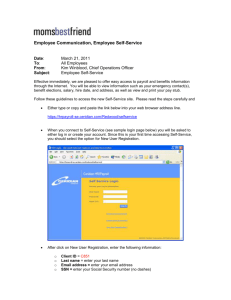Research Journal of Applied Sciences, Engineering and Technology 5(16): 4082-4087,... ISSN: 2040-7459; e-ISSN: 2040-7467
advertisement
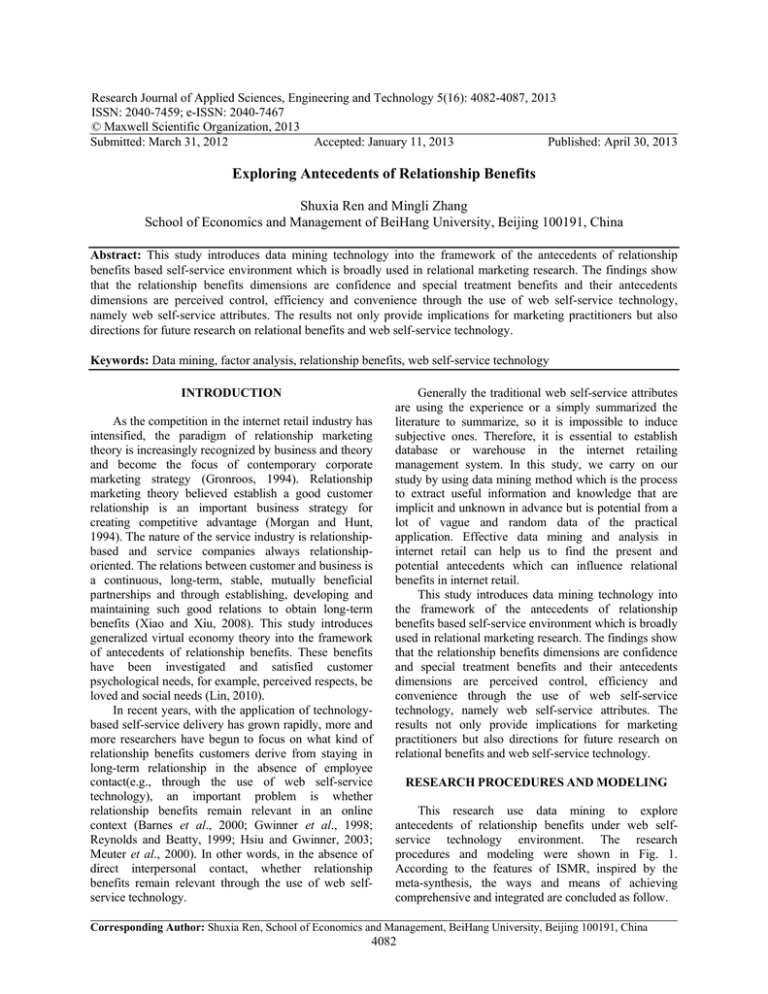
Research Journal of Applied Sciences, Engineering and Technology 5(16): 4082-4087, 2013 ISSN: 2040-7459; e-ISSN: 2040-7467 © Maxwell Scientific Organization, 2013 Submitted: March 31, 2012 Accepted: January 11, 2013 Published: April 30, 2013 Exploring Antecedents of Relationship Benefits Shuxia Ren and Mingli Zhang School of Economics and Management of BeiHang University, Beijing 100191, China Abstract: This study introduces data mining technology into the framework of the antecedents of relationship benefits based self-service environment which is broadly used in relational marketing research. The findings show that the relationship benefits dimensions are confidence and special treatment benefits and their antecedents dimensions are perceived control, efficiency and convenience through the use of web self-service technology, namely web self-service attributes. The results not only provide implications for marketing practitioners but also directions for future research on relational benefits and web self-service technology. Keywords: Data mining, factor analysis, relationship benefits, web self-service technology INTRODUCTION As the competition in the internet retail industry has intensified, the paradigm of relationship marketing theory is increasingly recognized by business and theory and become the focus of contemporary corporate marketing strategy (Gronroos, 1994). Relationship marketing theory believed establish a good customer relationship is an important business strategy for creating competitive advantage (Morgan and Hunt, 1994). The nature of the service industry is relationshipbased and service companies always relationshiporiented. The relations between customer and business is a continuous, long-term, stable, mutually beneficial partnerships and through establishing, developing and maintaining such good relations to obtain long-term benefits (Xiao and Xiu, 2008). This study introduces generalized virtual economy theory into the framework of antecedents of relationship benefits. These benefits have been investigated and satisfied customer psychological needs, for example, perceived respects, be loved and social needs (Lin, 2010). In recent years, with the application of technologybased self-service delivery has grown rapidly, more and more researchers have begun to focus on what kind of relationship benefits customers derive from staying in long-term relationship in the absence of employee contact(e.g., through the use of web self-service technology), an important problem is whether relationship benefits remain relevant in an online context (Barnes et al., 2000; Gwinner et al., 1998; Reynolds and Beatty, 1999; Hsiu and Gwinner, 2003; Meuter et al., 2000). In other words, in the absence of direct interpersonal contact, whether relationship benefits remain relevant through the use of web selfservice technology. Generally the traditional web self-service attributes are using the experience or a simply summarized the literature to summarize, so it is impossible to induce subjective ones. Therefore, it is essential to establish database or warehouse in the internet retailing management system. In this study, we carry on our study by using data mining method which is the process to extract useful information and knowledge that are implicit and unknown in advance but is potential from a lot of vague and random data of the practical application. Effective data mining and analysis in internet retail can help us to find the present and potential antecedents which can influence relational benefits in internet retail. This study introduces data mining technology into the framework of the antecedents of relationship benefits based self-service environment which is broadly used in relational marketing research. The findings show that the relationship benefits dimensions are confidence and special treatment benefits and their antecedents dimensions are perceived control, efficiency and convenience through the use of web self-service technology, namely web self-service attributes. The results not only provide implications for marketing practitioners but also directions for future research on relational benefits and web self-service technology. RESEARCH PROCEDURES AND MODELING This research use data mining to explore antecedents of relationship benefits under web selfservice technology environment. The research procedures and modeling were shown in Fig. 1. According to the features of ISMR, inspired by the meta-synthesis, the ways and means of achieving comprehensive and integrated are concluded as follow. Corresponding Author: Shuxia Ren, School of Economics and Management, BeiHang University, Beijing 100191, China 4082 Res. J. Appl. Sci. Eng. Technol., 5(16): 4082-4087, 2013 Table 1: Reliability and discriminant validity test α CR PC CV EF CB STB PC 0.81 0.86 0.77 0.76 0.74 0.79 0.80 CV 0.86 0.83 0.39 0.51 0.48 0.57 0.56 EF 0.92 0.80 0.63 0.43 0.40 0.59 0.72 CB 0.80 0.87 0.56 0.39 0.47 0.63 0.45 STB 0.86 0.92 0.34 0.58 0.59 0.46 0.66 PC, CV, EF, CB, STB refers to “perceived control”, “convenience”, “efficiency”, “confidence benefits”, “special treatment benefits”. from internet bookstores or travel agencies. Participants were asked to respond to the questions based on their previous purchasing experiences. Firstly, all participants choose a online bookstore or a travel agency which they usually invite to. Then they should describe the relationship with online bookstore or travel agency and what benefits they gain from the relationship. Each interview was limited at 20-25 min. In the interview process, we have directions to ensure the accuracy of our interview content. We use survey methods to collect data of webbased self-service attributes (perceived control, convenience and efficiency) and relationship benefits (confidence benefits and special treatment benefits). Perceived control, convenience and efficiency were measured adapted from scale of Dabholak (1996) to depict the nature of web self-service attributes. Each attribute was measured with two items. Relationship benefits were modified from the measures used by scale of Gwinner et al. (1998) and Gremler and Gwinner (2000). Social benefits are not being considered in the absence of employee contact. Data selection: The questionnaire survey began in 8 January 2011 and ended in 12 May 2011. A total of 368 subjects participated in this study and 312 questionnaires were returned, 84.7% recovery rate. After the invalid questionnaires removed, 297 effective questionnaires returned, effective recovery rate of 80.7%. Data testing: To examine the reliability of the scales of perceive control, convenience and efficiency, we computed cronbach’s alphas (α) and Construct Reliability (CR) for the scales (the results were shown in Table 1): Fig. 1: Research procedures and modeling Measure tools selection: We use depth interview to achieve the following purposes: • • • Explore what kinds of relationship benefits exists in internet retail Investigate what antecedents of relationship benefits can be identified Analyze the influence mechanism which refers to that antecedents affect relationship benefits The interview sample included MBA students of a university who have previous experience with purchases (1) where, λ means factor loadings of observed variables on latent variable θ means measurement error of observed variables. High value means a high internal consistency among the items and with their related constructs. To test the validity of scales, we test the discriminant validity by conducting a confirmatory factor analysis and analyzing the covariance matrix using the maximum likelihood procedure of Amos 7.0 4083 Res. J. Appl. Sci. Eng. Technol., 5(16): 4082-4087, 2013 z1= z=2 z=3 z=p (the results were shown in Table 1). This showed that the correlation coefficient between factors were lower than the average variance extracted of the individual factors, confirming discriminant validity. Modeling of factor analysis: Factor analysis is used to describe a few factors among many of the indicators or the relations between them and use few factors to reflect the information of the original statistical data analysis methods. The core of factor analysis is to show most information of original variables through a few independent factors (Xue, 2006). We assume that there are n samples, each n sample has p variables X 1 ,…X p , which constitute a n×p matrix as follows: x11 x21 xn1 x12 x1 p x22 x2 p xn 2 xnp k =1 ri j = ∑(x ki − xi ) ( xkj − x j ) ki − xi ) ( xkj − x j ) 2 k =1 n ∑(x k =1 ∑λ (2) (3) Factor analysis require original variables have a relatively strong correlation, therefore, factors analysis need to firstly carry on correlation analysis to calculate the correlation coefficient between the original variable matrix. When we conduct statistical tests on correlation matrix, most of the correlation coefficients are less than 0.3 and did not pass the test, these original variables are less suitable for factor analysis: n k k l21 z1 + l22 z2 + l23 z3 + + l2 m zm + ε 2 r12 r1 p r22 r2 p rn 2 rnp (i = 1, 2, p ) ∑λ l31 z1 + l32 z2 + l33 z3 + + l3m zm + ε 3 r11 r 21 R= rn1 (6) Then we can compute correlation matrix eigenvalues and their corresponding orthonormal eigenvectors μ i . According tothecorrelationcoefficient matrix eigenvalue, we can calculate the cumulative variance contribution rate and contribution rate of common factor z j : λi l11 z1 + l12 z2 + l13 z3 + + l1m zm + ε1 l p1 z1 + l p 2 z2 + l p 3 z3 + + l pm zm + ε p µ p1 x1 + µ p 2 x2 + µ p 3 x3 + + µ pm xm + ε p p Each variable is 0.000 mean and at 1.000 standard deviation level. The original variable can be expressed as a linear combination by m (m<p) factors as follows: x1 = x2 = x3 = x p = µ11 x1 + µ12 x2 + µ13 x3 + + µ1m xm + ε1 µ21 x1 + µ22 x2 + µ23 x3 + + µ2 m xm + ε 2 µ31 x1 + µ32 x2 + µ33 x3 + + µ3m xm + ε 3 k =1 p i ∑λ k =1 (i = 1, 2, p ) k (7) After principal component analysis to get the common factors is the original variables integrated. In the actual application of the analysis, we obtain the relations between factor variables and original variables mainly through the loading matrix analysis, thus named a new factor variable. The use of factor rotation method can make factor variables more explanatory. Then we can calculate the principal component loading and build loading matrix A: = ai j (4) 2 (5) There are many methods of factor analysis, such as principal component analysis, maximum likelihood, least squares method and so on. Principal component analysis is the most widely used method. This method transforms the original relevant variables X 1 ,…,X p to another set of unrelated variables z 1 ,…,z p (principal components ): 4084 λi lij (i, j − 1, 2, p ) a11 a12 a a22 21 A= a p1 a p 2 l11 λ1 l λ = 21 1 l p1 λ1 a1 p a2 p a pp l12 λ2 l22 λ2 l p 2 λ2 l1 p λ p l2 p λ p l pp λ p (8) x1= a11 z1 + a12 z2 + + a1 p z p x2= a21 z1 + a22 z2 + + a2 p z p x = a z + a z + + a z m1 1 m2 2 mp p m z1 = l11 x1 + l12 x2 + + l1 p x p z2 = l21 x1 + l22 x2 + + l2 p x p z = l x + l x + + l x mp p m m1 1 m 2 2 (9) Res. J. Appl. Sci. Eng. Technol., 5(16): 4082-4087, 2013 Following factor variables determined, we hope to get factor scores of each sample data and firstly calculate the factor in the form of linear combination of original variables. Here we can find the factor loading as follows: a11 a 21 A= a p1 a1m a2 m a pm a12 a22 ap2 l11 λ1 l λ = 21 1 l λ p1 1 l12 λ2 l22 λ2 l p 2 λ2 l1m λm l2 m λm l pm λm GFI = 1 − (10) Modeling of structural equation modeling: Measure model can be used to measure the relations between endogenous latent variables and exogenous latent variables: = x xˆξ + δ = y yˆη + ε where η means endogenous variables, ξ means exogenous variables, B means relations among endogenous latent variables, means the effects of exogenous variables on endogenous variables, ζ means structural equation residuals. We use a series of indexes to estimate the fit statistics as follows: 2 χ= ( n − 1) F 1 df= ( p + q )( p + q + 1) − t 2 (13) ( ) F s, ∑ θˆ F s, ∑ ( 0 ) RMSEA = (11) (12) Actual value 2.18 0.949 0.918 0.932 0.945 0.956 0.032 0.061 0.073 ( p + q )( p + q + 1) 2 (1 − GFI ) AGFI = 1− df NFI = where, ξ means endogenous variables, η means exogenous variables, x means endogenous indicator, y means exogenous indicator, δ means endogenous variables error, ε means exogenous variables error, x̂ means relations between endogenous indexes and endogenous variables, ŷ means relations between exogenous indexes and exogenous variables. Structural model can be used to measure the relations among latent variables: η = Bη + Γξ + ζ Table 2: SEM fit indexes Fit index Recommended value χ2/df <5 GFI >0.9 AGFI >0.9 NFI >0.9 IFI >0.9 CFI >0.9 RMR <0.05 RMSEA <0.08 P >0.05 All correlations are significant at the 0.001 level IFI = F̂0 df x02 − xt2 x02 x02 − xt2 x02 − dft CFI = 1 − τt τ0 (14) (15) (16) (17) (18) (19) where x2 0 derives from the independent model and x2 t derives from the target model. All the structural equation model fit indexes recommended values are show in Table 2. RESULTS OF DATA MINING Results of factor analysis: The factors loading are shown in Table 3. All the factor loadings were greater than recommended value, which means there are three antecedents of relationship benefits which are perceived control, convenience and efficiency. Similarly, there are two dimensions of relationship benefits which are confidence benefits and special treatment benefits. The analysis proceeds to examine the structural model. A procedure was used to estimate the model. The overall model fit (χ2/df = 2.18, CFI = 0.949, AGFI = 0.918, NFI = 0.932, IFI = 0.945, CFI = 0.956, RMR = 0.032, RMSEA = 0.061, P = 0.073) provides an acceptable fit of the data. The details are shown in Table 2. where, n represents the number of samples, F means the least value of fit function, p represents the number of independent variables, q represents the number of dependent variables, t means the number of free Results of structural equation modeling: Table 4 and variables. The value of χ2 smaller means the difference Fig. 2 show the structural model results. The results between the actual matrix and input matrix is smaller show that perceived control is significantly related to and the proposed model and sample data has high degree fit: confidence benefits (β = 0.256, t = 7.532), H1a is 4085 Res. J. Appl. Sci. Eng. Technol., 5(16): 4082-4087, 2013 Perceived Control 0.256 0.115 Confidence Benefits 0.232 Convenience 0.533 Special Treatment Benefits 0.256 Efficiency 0.386 Fig. 2: Structural model results Table 3: Results of factor analysis PC CV EF PC1 0.79 PC2 0.86 CV1 0.78 CV2 0.83 EF1 0.68 EF2 0.71 CB1 CB2 STB1 STB2 STB3 Table 4: Standard path coefficient Path Coefficient PC→CB 0.256 PC→STB 0.115 CV→CB 0.232 CV→STB 0.533 EF→CB 0.256 EF→STB 0.386 CB STB 0.80 0.82 0.81 0.69 0.74 t-value 7.532 0.961 0.826 9.187 0.784 8.993 t-value 8.795 9.962 5.104 4.672 10.013 8.720 24.413 23.059 17.532 16.996 8.396 Estimate result Supported Not supported Not supported Supported Not supported Supported supported. In contrast, the positive relationship between perceived control and special treatment benefits (β = 0.115, t = 0.961) is not significant, which does not support H1b. Contrary to that of perceived control, convenience is significantly associated with special treatment benefits (β = 0.533, t = 9.187) but not the case for confidence benefits (β = 0.232, t = 0.826), thus H2b is supported whereas H2a is not supported. Efficiency is not significantly associated with confidence benefits (β = 0.256, t = 0.784) which does not support H3a, while the positive impact it has on special treatment benefits is significant (β = 0.386, t = 8.933), which supports H3b. types of relationship benefits and three types of antecedents based on data mining. Our findings have the following contributions to theories. Firstly, this study extends for prior research that has been investigated in more traditional face-to-face contexts. The findings suggest that relationship benefits constructs remain relevant in web-based environment. This supports the previous opinions that there is a weaker relationship with service providers when internet-based transactions. That is, relationship with a web interface is significantly different from relationships with people. However, despite these differences exits, we can still derive benefits from their mutual relations. Finally, this study explored three types of web selfservice attributes as relationship benefits antecedents. That is, perceived control, convenience and efficiency. Perceived control has positive influence on confidence benefits, whereas convenience and efficiency have positive influence on special treatment benefits. Managerial implications: With the understanding that confidence and special treatment benefits play an important role in marketing strategy, these could be used in comparisons to competitors, in that a firm’s services could be positioned at creating greater confidence in the service or delivering greater levels of special treatment benefits than can be provided by competing offers. Furthermore, firms can consider factors of either the technological aspects of their delivery system or the specific services offered that might also instill greater confidence or add to the receipt of special treatment benefits. For instance, up-to-date features on a website may serve to increase confidence benefits and time-save pay could increase special treatment benefits. The database capability of web commerce represents a potential powerful way of enhancing the relations between firms and customers. Database not only used to record customer preferences and give suggestions based on previous preference, but also used to keep track of information and products purchased in prior visits. These capabilities can be used to enhance the virtual relationship customers have with the internet retail. ACKNOWLEDGMENT The authors would like to thank the anonymous reviewers and the editors for their constructive criticism and comments. This study was supported in part by a grant from the CONCLUSION National Natural Science Foundation of China for funding (70972002) and Special foundation of Implication of research: This study proposed and investigated relationship benefits and antecedents in Generalized Virtual Economy Research (GX2011web self-service. In internet retail context, we find two 1003(Y)). 4086 Res. J. Appl. Sci. Eng. Technol., 5(16): 4082-4087, 2013 REFERENCES Barnes, J.G., P.A. Dunne and W.J. Glynn, 2000. SelfService and Technology: Unanticipated and Unintended Effects on Customer Relationships. In: Swartz, T.A. and D. Iacobucci (Eds.), Handbook of Services Marketing and Management. Thousands Oaks, CA: Sage, 10: 89-102. Gremler, D.D. and K.P. Gwinner, 2000. Customeremployee rapport in service relationships. J. Serv. Res., 3: 82-104. Gronroos, C., 1994. From marketing mix to relationship marketing: Towards a paradigm shift in marketing. Manag. Decis., 32: 4-20. Gwinner, K.P., D.D. Gremler and M.J. Bitner, 1998. Relational benefits in service industries: The customer’s perspective. J. Acad. Market. Sci., 26: 14-101. Hsiu, J.R.Y. and K.P. Gwinner, 2003. Ineternet retail customer loyalty: The mediating role of relational benefits. Internet Retail Customer Loyalty, 14: 483-500. Lin, Z., 2010. The Generalized Virtual Economy. People Press, China, pp: 428-469. Meuter, M.L., A.L. Ostrom, R.I. Roundtree and M.J. Bitner, 2000. Self-service technologies: Understanding customer satisfaction with technology-based service encounters. J. Marketing, 64: 50-64. Morgan, R.M. and S.D. Hunt, 1994. The commitmenttrust theory of relationship marketing. J. Marketing, 58: 20-38. Reynolds, K.E. and S.E. Beatty, 1999. Customer benefits and company consequences of customersalesperson relationships in retailing. J. Retailing, 75: 11-32. Xiao, L. and S. Xiu, 2008. Generalized Virtual Economy Paper. Aviation Industry Press, China, pp: 38-51. Xue, W., 2006. SPSS Data Analysis. China Renmin University Press, China. 4087

